by Jason Borger
This is the first report discussing the on-going Montana State University (MSU)/Fly Casting Institute (FCI) fly-casting motion-capture sessions at MSU in Bozeman, Montana.
 |
|
Casting with motion-capture and muscle-capture gear in place. |
The motion capture session was designed to not only provide a deeper look at fly casting in three dimensions (with nearly seven times the chronological detail of regular video), but also to more closely assess upper-extremity muscle/bone/joint interactions from a sports-medicine perspective. The combination of the 18 tracking balls and the 8 leads allowed casting motions and muscle firing to be captured simultaneously.
Getting set-up for the session required stripping to the waist in order to get the tracking balls in place along with the leads. Not a big deal, except that the balls were outfitted with some fairly serious adhesive. That adhesive made the balls easy to attach, but peeling them off at day's end was a bit of an adventure. Of course, what's a little pain when it's all for fly-casting science?! The leads proved easier to deal with from an on/off perspective, but the wires required some care when casting.
Part of getting everything in place involved proper placement of the leads for the muscle sensors, as well as making sure that the computer wasn't confused as to which tracking balls were which. Some simple muscle tensing and prodding was all that was required to get the leads situated properly. Keeping the computer satisfied was also a relatively simple task that involved acquiring specific arm and hand dimensions and linking those to the capture software on the PC.
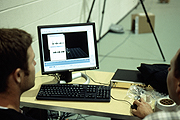  |
|
(left) The PC workstation being set up by Mike and Tyler. (right) Me getting prepped with balls and leads. At this point, Mike is making sure that a lead is attached over the desired muscle in my forearm (left to right: Tim, me, Tyler, and Mike). |
All of the casting equipment used was also rigged for motion capture. The fly rod and line both sported a number of wraps of silver reflective tape at various points. The tape allowed the flexing and un-flexing of the rod and the initial unrolling of the line loop from the rod's tip to be captured. The reel was also tracked in 3-D. Once everything was in place and determined to be working, the system was calibrated and we were ready to start casting.
After the first "real" cast in the eyes of the cameras, we discovered that anyone casting was going to have to do so on his knees. Because of the camera positions and heights, some rod and line data was lost if a caster stood upright, so on our knees it was--in my case, for the better part of two hours. Since there was to be no data collection of the lower body, and since casting room was restricted anyway, not being able to stand was not really an issue as far as results were concerned (my knees have yet to forgive me, though).
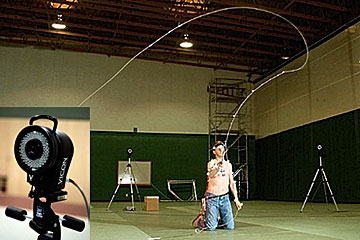 |
|
(main photo) Casting for the cameras (two of which can be seen on the tripods behind me). (inset) Close-up of one of the six total cameras used. |
The casting in the day's session ran the gamut from overhead casts, to sidearm casts, to elliptical casts, to cross-body/across-the-head casts and even some limited Spey moves. In addition, double hauling was done, along with shooting line, drifting in various forms, thrusting, extreme wrist rotation (as in some distance techniques) and arm-only casting (minimizing wrist involvement as much as possible). There was also a sub-session involving rod frequency.
 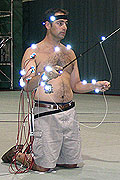 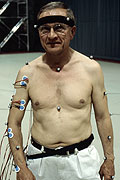 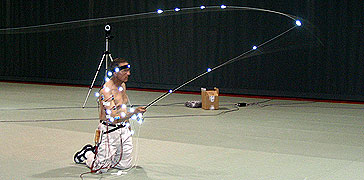 |
|
(top-left to right) Tim prepping for battle. Tim "lit up" during casting by the flash of a digital still camera. Server, fully wired and ready to make his motion-capture debut. (bottom) Server completing a cast, also "lit up" by the flash of a digital still camera. Note the reflective tape wraps used on the rod and line. |
Motion capture of this type does not produce a "normal" video image (such as one would see with a camcorder). Instead it produces what might be described as a "dot-to-dot" image, with each "dot" corresponding to one of the tracking balls or tape wraps. Watching my own body as a dot-to-dot caster was instantly fascinating and set my mind racing. Then seeing it all in slo-mo, frame-by-detailed-frame, only made it better. Watching it all move and turn in space is, in my opinion, a thing of kinetic beauty.
A more-advanced motion capture session is already in the planning stages (slated for January 5-6, 2005). Hopefully that next session will yield an even richer and more complete data set, and serve to further advance our collective understanding of the science, medicine and art of fly casting.
Casting photos courtesy of MSU. Preparation photos by Jason and Kelley Borger.
Copyright © Fly Casting Institute. All Rights Reserved.
![]()